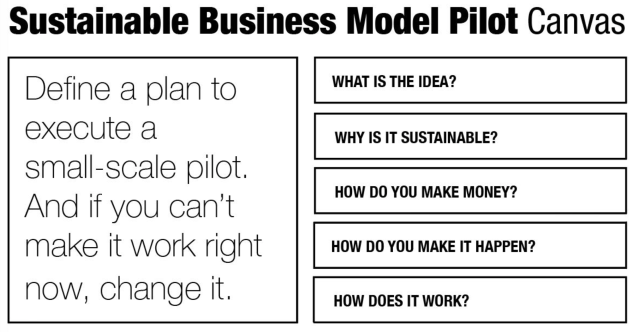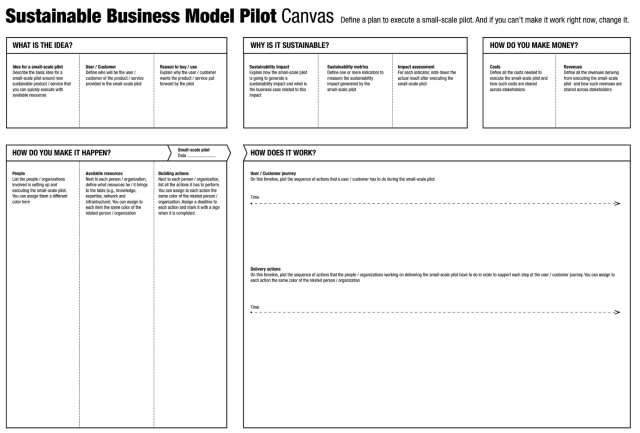[Note: This is the 28th post in our “Papers in Brief” series. This series offers a special service as it explains the core ideas of chosen research papers in a nutshell.]
Papers in Brief (XXVIII) by Brian Baldassarre, Jan Konietzko, Phil Brown, Giulia Calabretta, Nancy Bocken, Ingo Karpen and Erik Jan Hultink
Baldassarre, B., Konietzko, J., Brown, P., Calabretta, G., Bocken, N., Karpen, I. O., & Hultink, E. J. (2020). Addressing the design-implementation gap of sustainable business models by prototyping: A tool for planning and executing small-scale pilots. Journal of Cleaner Production, 255, 120295, https://doi.org/10.1016/j.jclepro.2020.120295.
Background and relevance
Next to the redesign of industrial products and processes, sustainable business model innovation is a strategic approach to integrate environmental and social concerns into the objectives and operations of organizations (Bocken et al., 2014; Stubbs and Cocklin, 2008). To foster sustainable business model innovation in practice, there has been recent emphasis on the development of tools (Breuer et al., 2018). However, a closer analysis of these tools shows that most of them (e.g. Joyce and Paquin, 2016; Upward and Jones, 2016) focus on how to ideate and design new sustainable business models and not on their implementation (Bocken et al., 2019). Indeed, new sustainable business models are rarely implemented successfully on the market (Ritala et al., 2018). In sustainable business model innovation research, this issue is referred to as a “design-implementation gap” (Geissdoerfer et al., 2018), which must be addressed in order to achieve the positive social and environmental impact promised in theory (Tukker, 2004; 2015).
In order to support sustainable business model innovation in bridging this gap, we connect to strategic design and business experimentation research, two approaches that discuss how to bring business concepts from ideation to market launch through an iterative innovation process (Calabretta et al., 2017; Chesbrough, 2010). Within these approaches, prototyping is an essential practice to get business model ideas implemented (Calabretta et al., 2016; Ries, 2011). Indeed, prototyping allows to quickly creating basic versions of new physical or digital artifacts, testing and gradually improving the business ideas around them by running a series of iterative small-scale pilots (Calabretta et al., 2016; Ries, 2011). Thus, the aim of this paper is to transfer relevant prototyping expertise into the field of sustainable business model innovation, exploring how this practice can be leveraged to get sustainable business model ideas defined “on paper” into tangible entities unfolding in “the reality of practice.” To this end, we develop a tool to set up small-scale pilots and bridge design-implementation gap of sustainable business models.
Research method
Our study follows a design science research methodology (Peffers et al., 2007), applied in the context of innovation management (Romme and Reymen, 2018). Design science research generates scientific knowledge about a theoretical issue by creating and evaluating an artifact through empirical work (Peffers et al., 2007). Artifacts include tools to address organizational and innovation management challenges (Van Aken and Romme, 2009). Through this process, we iteratively develop, apply and evaluate our tool by working with nine startups and one multinational company. Based on the learning and outcome of this process, we provide normative theory to advance sustainable business model innovation research.
Results
The main outcome of our study is the sustainable business model pilot canvas. This tool aims to support small and large organizations in bridging the design-implementation gap of their sustainable business model ideas, helping them to turn negative impacts into positive sources of value. Specifically, the tool supports building prototypes and planning specific actions needed for executing small-scale pilots. Working with the tool entails considering the following elements:
What is the idea? (Sustainable Value Proposition)
- Description of the main idea for a small-scale pilot around a new sustainable product/service that can be quickly executed with available resources.
- Definition and description of who will be the user/customer of the product/service provided in the pilot.
- Explanation of why the user/customer wants the product/service put forward by the pilot
Why is it sustainable? (Sustainability Impact)
- Explanation of the sustainability impact generated by the pilot and the related business case
- Definition of one or more indicators to measure the sustain- ability impact generated by the pilot.
- Assessment of the actual results for each indicator after executing the pilot
How do you make money? (Sustainable Value Capture)
- Definition of the costs needed to execute the pilot and how such costs are shared across stakeholders.
- Definition of the revenues deriving from executing the pilot and how such costs are shared across stakeholders.
How do you make it happen? (Sustainable Value Creation)
- List of all the people/organizations involved in setting up and executing the pilot.
- List of the resources (e.g., knowledge, expertise, network, and infrastructure) that each person/organization brings to the table to set up the pilot.
- List of all the actions that each person/organization performs to set up the pilot.
How does it work? (Sustainable Value Delivery)
- Sequence of actions that a user/customer has to do during the pilot.
- Sequence of actions that the people/organizations working on delivering the pilot have to do in order to support each step of the user/customer journey.


Fig. 1: The SBM Pilot Canvas
Our empirical work challenges current assumptions within sustainable business model innovation theory; namely, that it is necessary to first conceptualize a sustainable value proposition, and then focus on the other dimension of sustainable value creation delivery and capture (Baldassarre et al., 2017; Bocken et al. 2013; 2018). Conversely, we argue that this sequential approach results in operational and financial bottlenecks, which are exacerbated by sustainability impact requirements, ultimately leading to a design-implementation gap (Geissdoerfer et al., 2018).
Our study demonstrates that piloting a prototype, forces organizations to simultaneously consider the desirability (i.e., what users want), feasibility (i.e., what is technically achievable), viability (i.e., what is financially possible), and sustainability (i.e., what is economically, socially and environmentally acceptable) of a new business model. Doing so early on is functional to bridge the design-implementation gap of sustainable business models.
References
Baldassarre, B., Calabretta, G., Bocken, N. M. P., and Jaskiewicz, T. (2017). Bridging sustainable business model innovation and user-driven innovation: A process for sustainable value proposition design. Journal of Cleaner Production, 147, 175-186.
Baldassarre, B., Schepers, M., Bocken, N., Cuppen, E., Korevaar, G., & Calabretta, G. (2019). Industrial Symbiosis: Towards a design process for eco-industrial clusters by integrating Circular Economy and Industrial Ecology perspectives. Journal of cleaner production, 216, 446-460.
Bocken, N. M., Schuit, C. S., & Kraaijenhagen, C. (2018). Experimenting with a circular business model: Lessons from eight cases. Environmental innovation and societal transitions, 28, 79-95.
Bocken, N., Boons, F., & Baldassarre, B. (2019). Sustainable business model experimentation by understanding ecologies of business models. Journal of cleaner production, 208, 1498-1512.
Breuer, H., Fichter, K., Lüdeke-Freund, F., & Tiemann, I. (2018). Sustainability-oriented business model development: Principles, criteria, and tools. International Journal of Entrepreneurial Venturing, 10(2), 256-286.
Calabretta, G., Gemser, G., & Karpen, I. (2016). Strategic Design: Eight essential practices every strategic designer must master. Bis publishers.